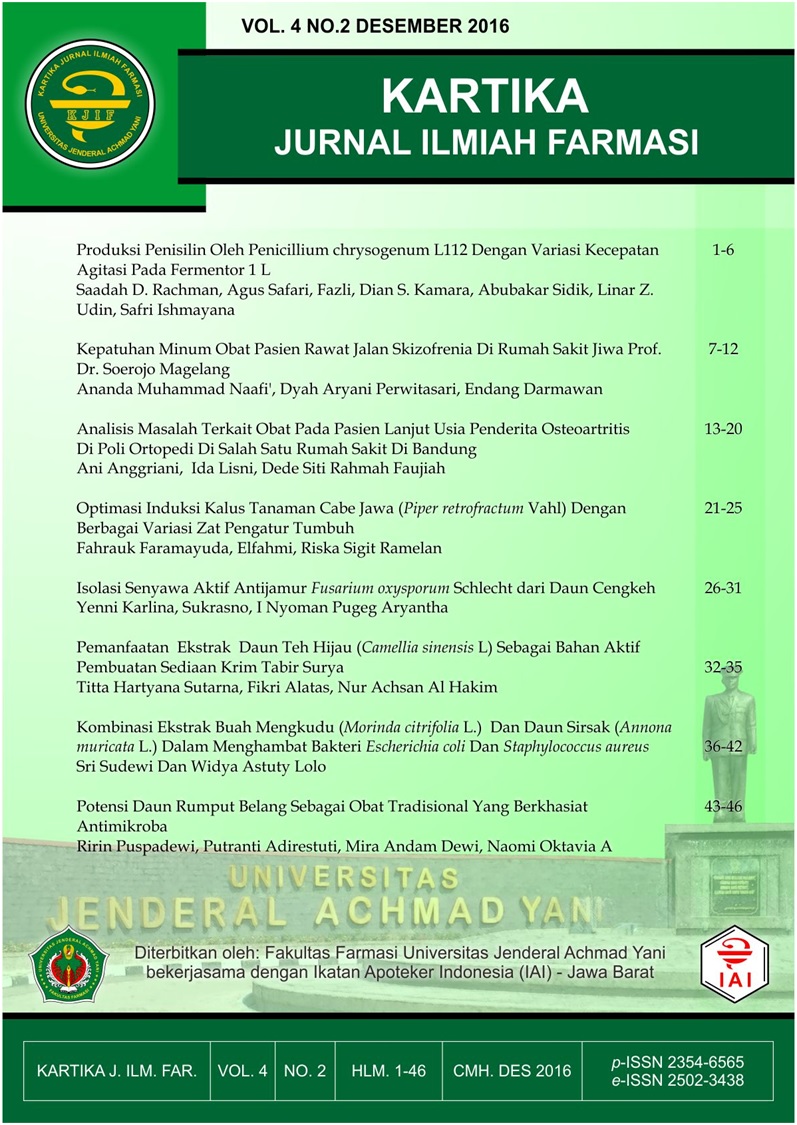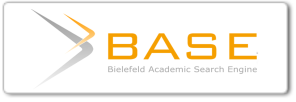ISOLASI SENYAWA AKTIF ANTIJAMUR Fusarium oxysporum Schlecht DARI DAUN CENGKEH
DOI:
https://doi.org/10.26874/kjif.v4i2.63Abstrak
ABSTRAK
Â
Pada penelitian ini telah dilakukan isolasi dan identifikasi senyawa aktif antijamur dari ekstrak n-heksan, etil asetat ,methanol dan minyak atsiri tanaman obat daun cengkeh ( Syzygium aromaticum (L.) Merrill and Perry), terhadap pertumbuhan jamur Fusarium oxysporum Schlecht. Uji aktivitas antijamur menggunakan metode difusi agar dengan menghitung prosentase penghambatan pertumbuhan radial miselium jamur pada hari ke tujuh. Konsentrasi ekstrak yang digunakan untuk uji aktivitas antijamur, yaitu 2,5%, 5%, dan 10%. Ekstrak n-heksan dan minyak atsiri daun cengkeh memiliki aktivitas antijamur tinggi, yaitu 76-100%. Selanjutnya, ekstrak n-heksan difraksinasi menggunakan kromatografi cair vakum, kromatografi kolom dan kromatotron. Identifikasi senyawa dianalisis dengan Kromatografi Lapis Tipis (KLT) dan Kromatografi Gas-Spektroskopi Massa (KG-SM). Pada ekstrak n-heksan yang didapatkan 2 subfraksi. Subfraksi 1 memiliki aktivitas antijamur 32,72% pada konsentrasi 5% dan subfraksi 2 dengan aktivitasnya 90,90% pada konsentrasi 2,5%. Data KG-SM menunjukkan kandungan utama subfraksi 1 adanya senyawa karyofilen (BM 204) dan subfraksi 2 eugenol (BM 164).
Â
Kata kunci : Antijamur, Fusarium oxysporium, tanaman obat
Â
ABSTRACT
Â
This research has been performed, the isolation and identification the antifungal activity of extracts of n-hexane, ethyl acetate, methanol and essential oils from medicinal plant cloves (Syzygium aromaticum (L.) Merrill and Perry), against the growth of the fungus Fusarium oxysporum Schlecht. Antifungal activity test, using the jelly diffusion method by calculating the percentage inhibition of radial growth of fungal mycelium on the seventh day. Concentration of extract used to test the antifungal activity was 2.5%, 5% and 10%. N-hexane extracts and essential oils of clove leaf has a high antifungal activity, which is 76-100%. Further, n-hexane extract was fractionated using vacuum liquid chromatography, chromatography columns and chromatotron. Identification of the compound was analyzed by Thin Layer Chromatography (TLC) and Gas Chromatography-Mass Spectroscopy (GC-MS). In the n-hexane extract obtained 2 subfractions. Subfraction 1 has antifungal activity of 32.72% at concentration of 5% and subfraction 2 has antifungal activity of 90.90% at concentration of 2,5%. GC-MS data shows that the major component of subfraction 1 was caryophyllene (M = 204) and subfraction 2 was eugenol (M =164).
Â
Keywords : Antifungal, Fusarium oxysporium, medicinal plant cloves.
Â
Referensi
Amin, M., Jassal, M. M. S., and Tygi, S. V. (2013): Phytochemical Screening and Isolation of Eugenol From Syzigium aromaticum by Gas Chromatography. Internasional Journal of Reseach in Phytochemistry and Pharmacology, 3(1) : 74-77
Carrasco, H., Raimondi, M., Stevaz, L., Liberto, M. D., Rodriguez, M. V., Espinoza, L., Madrid, A., and Zacchino, S. (2012): Antifungal Activity of Eugenol Analogues. Influence of Different Substituents and Studies on Mechanism of Action. Molecules. 17: 1002-1024
Cheng, S. S., Lin, J. Y., Chang, E. H., and Chang, S. T. (2008): Antifungal activity of cinnamaldehyde and eugenol congeners against wood-rot fungi. Jounal Bioresource Technology. 99 : 5145-5149
Cronquist, A.(1981) : An Integrated System of Classification of Flowering Plants. Columbia University Press. New York
Departemen Kesehatan RI. (1978): Materia Medika Indonesia. Jilid I-VI. Jakarta: Departemen Kesehatan RI
Fowlis, Ian A.,1998. Gas Chromatography Analytical Chemistry by Open Learning. John Wiley & Sons Ltd: Chichester. Khalimi, K and Suprapta, D. N. (2012): Anti-Fungal Activities of Selected Tropical Plants from Bali Island. Phytopharmacology, 2(2): 265-270
Manik, R. (2009): Uji Efektifitas Daun Cengkeh (Syzygium aromaticum L.) dan Daun Serai (Andropogon nardus L.) terhadap penyakit Antraknosa (Colletotrichum capsici (Syd) Buttler and Bisby) pada tanaman cabai (Capsicum annuum L.) dilapangan. Universitas Sumatera Utara. Medan
Memmou, F. and Mahboub., R. (2012): Composition of Essential Oil from Fresh Flower of Clove. Journal of Scientific Research in Pharmacy, 1(2): 33-35
Park, M.J., Gwak, K.S., Yang, I., Choi, W.S., Jo, H. J., Chang, J. W., Jeung, E. B., and Choi, I. G. (2007): Antifungal Activities of the Essensial Oils in Syzigium aromaticum (L.) Merr. Et Perry and Leptospermum petersonii Bailey and their Constituen against Various Dermatophytes. The Journal of Microbiologi, 45 (5): 460-465
Rahimi, A. A., Ashnagar, A and Hamideh, N. (2012) : Isolation and characterization of 4-allyl-2-methoxyphenol (eugenol) from Clove Buds Marketed In Tehran City of Iran. International Journal of ChemTech Research, 4(1): 105-10
Sastrahidayat, I.R., 1992. Ilmu Penyakit Tumbuhan Usaha nasional Surabaya Indonsia. Hal 365
Semangun H. 1994. Penyakit-penyakit Tanaman Hortikultura di Indonesia. Gadjah Mada University Press, Yogyakarta. Hal 556-561
Verma, R. K., Chaurasia, L., and Katiyar, S. (2007): Potential Antifungal Plants For Controlling Building Fungi. Natural Product Radiance, 7(4): 374-387
##submission.downloads##
Diterbitkan
Cara Mengutip
Terbitan
Bagian
Lisensi
Penulis yang menerbitkan artikel pada jurnal ini menyetujui ketentuan berikut:
- Penulis memberikan hak cipta dan jaminan atas artikel sebagai publikasi pertama, yang memberikan kesempatan pada orang lain untuk membagi artikel dibawah lisensi Creative Commons Attribution License
- Penulis dapat melakukan perubahan dan menambahkan untuk pendistribusian artikel yang terpublikasi secara non eksklusif (misalnya, mempostingnya ke repositori institusional atau mempublikasikannya dalam sebuah buku), dengan pengakuan publikasi awal dalam jurnal ini.
- Penulis diizinkan dan didorong untuk memposting pekerjaan mereka secara online (misalnya, di repositori institusional atau di situs web mereka) sebelum dan selama proses pengajuan, karena dapat mengarah pada pertukaran produktif, serta kutipan pekerjaan sebelumnya dan lebih besar yang diterbitkan (Lihat The Effect of Open Access).























